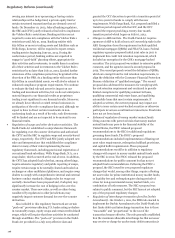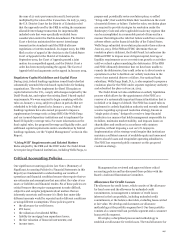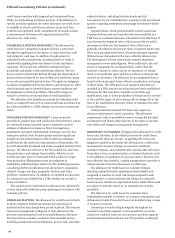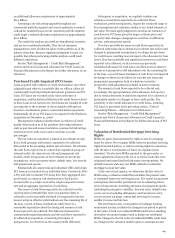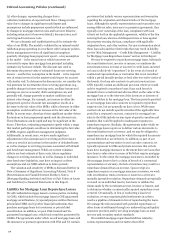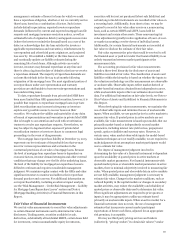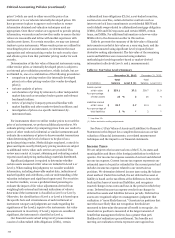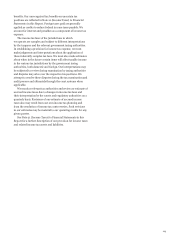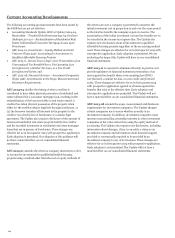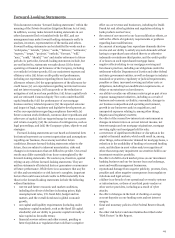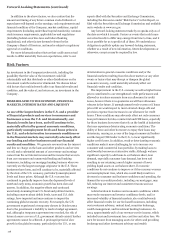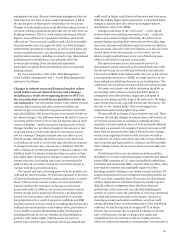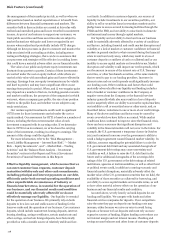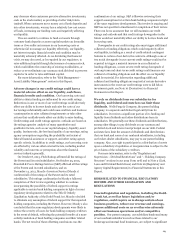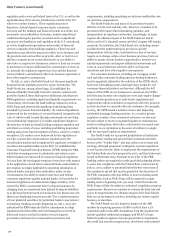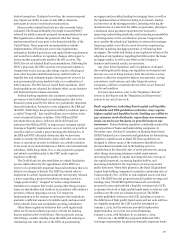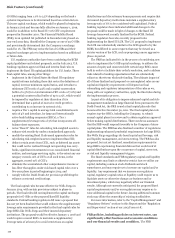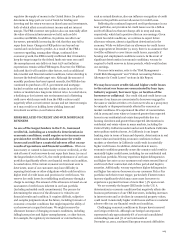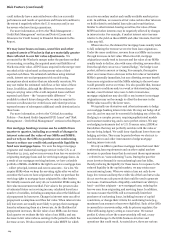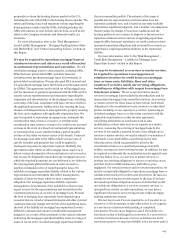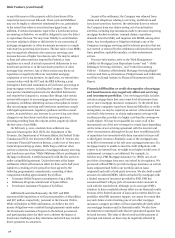Wells Fargo 2013 Annual Report Download - page 118
Download and view the complete annual report
Please find page 118 of the 2013 Wells Fargo annual report below. You can navigate through the pages in the report by either clicking on the pages listed below, or by using the keyword search tool below to find specific information within the annual report.
Forward-Looking Statements (continued)
In addition to the above factors, we also caution that the
amount and timing of any future common stock dividends or
repurchases will depend on the earnings, cash requirements and
financial condition of the Company, market conditions, capital
requirements (including under Basel capital standards), common
stock issuance requirements, applicable law and regulations
(including federal securities laws and federal banking
regulations), and other factors deemed relevant by the
Company’s Board of Directors, and may be subject to regulatory
approval or conditions.
For more information about factors that could cause actual
results to differ materially from our expectations, refer to our
reports filed with the Securities and Exchange Commission,
including the discussion under “Risk Factors” in this Report, as
filed with the Securities and Exchange Commission and available
on its website at www.sec.gov.
Any forward-looking statement made by us speaks only as of
the date on which it is made. Factors or events that could cause
our actual results to differ may emerge from time to time, and it
is not possible for us to predict all of them. We undertake no
obligation to publicly update any forward-looking statement,
whether as a result of new information, future developments or
otherwise, except as may be required by law.
Risk Factors
An investment in the Company involves risk, including the
possibility that the value of the investment could fall
substantially and that dividends or other distributions on the
investment could be reduced or eliminated. We discuss below
risk factors that could adversely affect our financial results and
condition, and the value of, and return on, an investment in the
Company.
RISKS RELATED TO THE ECONOMY, FINANCIAL
MARKETS, INTEREST RATES AND LIQUIDITY
As one of the largest lenders in the U.S. and a provider
of financial products and services to consumers and
businesses across the U.S. and internationally, our
financial results have been, and will continue to be,
materially affected by general economic conditions,
particularly unemployment levels and home prices in
the U.S., and a deterioration in economic conditions or
in the financial markets may materially adversely affect
our lending and other businesses and our financial
results and condition. We generate revenue from the interest
and fees we charge on the loans and other products and services
we sell, and a substantial amount of our revenue and earnings
comes from the net interest income and fee income that we earn
from our consumer and commercial lending and banking
businesses, including our mortgage banking business where we
currently are the largest mortgage originator in the U.S. These
businesses have been, and will continue to be, materially affected
by the state of the U.S. economy, particularly unemployment
levels and home prices. Although the U.S. economy has
continued to gradually improve from the depressed levels of
2008 and early 2009, economic growth has been slow and
uneven. In addition, the negative effects and continued
uncertainty stemming from U.S. fiscal and political matters,
including concerns about deficit levels, taxes and U.S. debt
ratings, have impacted and may continue to impact the
continuing global economic recovery. For example, the U.S.
government experienced a temporary closure in October 2013
due to the government’s inability to reach a budget agreement,
and, although a temporary agreement was reached, the risk of
future closures or even a U.S. government default exists if further
agreements cannot be achieved. A prolonged period of slow
growth in the global economy, particularly in the U.S., or any
deterioration in general economic conditions and/or the
financial markets resulting from the above matters or any other
events or factors that may disrupt or dampen the global
economic recovery, could materially adversely affect our
financial results and condition.
The improvement in the U.S. economy as well as higher home
prices contributed to our strengthened credit performance and
allowed us to release amounts from our allowance for credit
losses, however there is no guarantee we will have allowance
releases in the future. If unemployment levels worsen or if home
prices fall we would expect to incur elevated charge-offs and
provision expense from increases in our allowance for credit
losses. These conditions may adversely affect not only consumer
loan performance but also commercial and CRE loans, especially
for those business borrowers that rely on the health of industries
that may experience deteriorating economic conditions. The
ability of these and other borrowers to repay their loans may
deteriorate, causing us, as one of the largest commercial lenders
and the largest CRE lender in the U.S., to incur significantly
higher credit losses. In addition, weak or deteriorating economic
conditions make it more challenging for us to increase our
consumer and commercial loan portfolios by making loans to
creditworthy borrowers at attractive yields. Although we have
significant capacity to add loans to our balance sheet, loan
demand, especially consumer loan demand, has been soft
resulting in our retaining a much higher amount of lower
yielding liquid assets on our balance sheet. If economic
conditions do not continue to improve or if the economy worsens
and unemployment rises, which also would likely result in a
decrease in consumer and business confidence and spending, the
demand for our credit products, including our mortgages, may
fall, reducing our interest and noninterest income and our
earnings.
A deterioration in business and economic conditions, which
may erode consumer and investor confidence levels, and/or
increased volatility of financial markets, also could adversely
affect financial results for our fee-based businesses, including
our investment advisory, mutual fund, securities brokerage,
wealth management, and investment banking businesses. In
2013, approximately 25% of our revenue was fee income, which
included trust and investment fees, card fees and other fees. We
earn fee income from managing assets for others and providing
brokerage and other investment advisory and wealth
116


